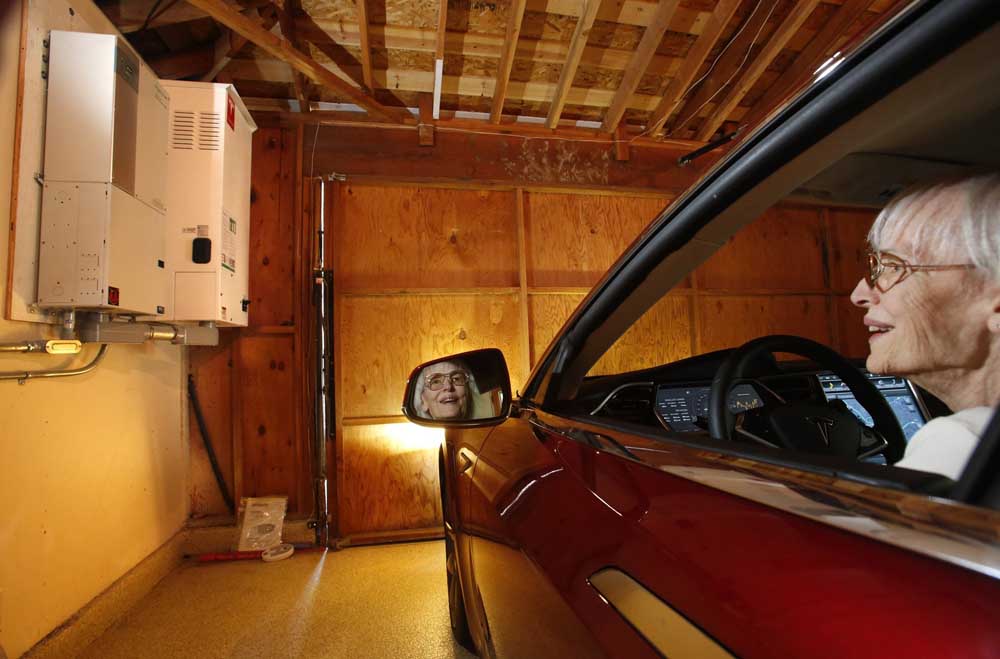Microgrid sales rise alongside qualms about the power grid
Published 12:00 am Sunday, June 29, 2014

- Don Bartletti / Los Angeles TimesSolar collectors on the roof of Cassina Tarsia’s home produce enough power to run all the household appliances and lights and the battery serves as reserve power for cloudy days and at night.
The periodic blackouts in Cassina Tarsia’s Oceanside, Calif., neighborhood meant the 71-year-old couldn’t charge her cellphone or electric wheelchair.
But outages aren’t a problem anymore.
Since February, Tarsia’s garage has housed a suitcase-sized battery that stores power from her rooftop solar panels and the main electrical grid. In a blackout, the battery can power her home for days or even weeks.
“I think about what will happen in a big earthquake and what happened in Japan with the tsunami,” said Tarsia, who paid $5,000 to get the battery installed. “I wanted to be prepared.”
Tarsia has joined a growing group of pioneering homeowners, government agencies and businesses using this kind of microgrid to reduce power bills and dependence on utility networks. Spending on microgrid projects in the U.S. is poised to explode to $19.9 billion in 2020 from $4.3 billion last year, according to Navigant Research, in part because of growing concerns about the reliability of the traditional grid.
“The U.S. is the leading market for microgrids because the quality of our power supply has gone down,” said Peter Asmus, a senior analyst at Navigant Research. “The storms on the East Coast in the last three years have accelerated that trend.”
Online commerce giant eBay Inc. invested in the technology for a data center. Oracle Corp. Chief Executive Larry Ellison and British mogul Richard Branson plan to set up microgrids on their islands. Even the Santa Rita Jail in Northern California has one.
Microgrids are alternative ways of generating, storing and using electricity. Sophisticated versions function as small-scale power systems that pull together different energy sources and can operate independently in an emergency.
Unlike diesel generators, which have long been used for emergency power, modern microgrids frequently integrate batteries with multiple sources of power, including solar panels, wind turbines and natural gas fuel cells.
Interest in microgrids has soared as America’s aging infrastructure has fallen behind a rising population that is increasingly hooked on digital gadgets, experts said.
Widespread blackouts from storms or other causes have laid bare the grid’s vulnerabilities. In California, a sophisticated attack last year on the Metcalf Transmission Substation near San Jose also raised concerns about the state’s power supply.
California has become a big market for microgrids because of the state’s aggressive push for renewable energy. State regulators last year mandated that investor-owned utilities — Southern California Edison, San Diego Gas & Electric and Pacific Gas & Electric — must expand their electricity storage capacity by 2020.
Interest also is growing because the economics make sense. Solar panel prices have fallen sharply. Recent advances in technology enable microgrids to separate safely from the main utility during outages and use only self-generated electricity. And in normal times, excess energy can be sold back to traditional utilities.
Power-hungry organizations such as corporations and universities can save a lot of money by adopting microgrids, experts said.
The California Institute of Technology generates more than 80 percent of its electricity from on-site sources such as solar, steam and natural gas. The University of California-San Diego saves about $850,000 a month on utility bills through a system of solar panels, fuel cells, generators and batteries, said Byron Washom, the university’s director of strategic energy initiatives.
Wal-Mart Stores Inc. is looking into microgrids to keep its stores and warehouses powered in bad weather.
The retail giant never invested widely in diesel generators for its stores because it didn’t make sense to shell out for something that might never be used, said David Ozment, Wal-Mart’s senior director of energy.
But Wal-Mart has experimented with renewable energy options; 41 stores in California are partially powered by fuel cells that run on natural gas or biogas harvested from landfills.
Smaller users also have started adopting microgrids.
Battery sales tripled in the past three years at Wholesale Solar Inc. with orders from places such as doctors’ offices and day traders interested in microgrids, said Mark Coleman, president of the Mount Shasta, Calif., company. He said many provide critical services or depend on computers to do their work.
“The stock market trader guys, they say, ‘I can lose the cost of the battery in an hour of not having electricity,’ ” he said.
Homeowners are just starting to explore microgrids, but they eventually could drive the industry’s growth — especially in areas with high electricity rates such as California, Hawaii, and the Northeast, analysts said.






